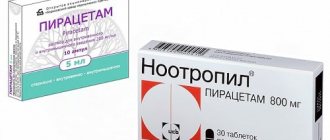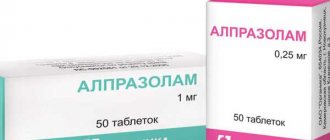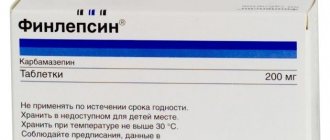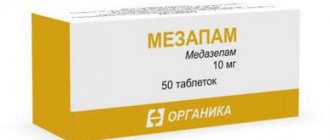The drug “Cymbalta” is presented on the market by pharmacological (“lilly”). This medication falls into the category of relatively expensive drugs, although, as a rule, many antidepressants and similar drugs are expensive. The price of this product depends, first of all, on the size of the package. The drug is available in pharmacies with a prescription; the minimum cost is approximately 850 rubles per pack.
The main active ingredient in Cymbalta is duloxetine. The substance works on the principle of reuptake of norepinephrine and serotonin, and also has a depressing effect on the production of dopamine. Duloxetine may be 30 mg or 60 mg. In addition, this antidepressant contains, for example, components such as sucrose, hypromellose acetate succinate, and white dye.
How to Simply Recommend
Why the medicine does not work The key to successful treatment is, of course, following all the doctor’s recommendations and informing him of all significant changes during therapy. However, a specialist can talk as much as he wants about the regimen and duration of taking the drug, but most patients will still violate these rules. Read more
Despite the fact that Cymbalta is primarily an antidepressant, this drug also has pain-relieving properties. So, for example, a medicine can ease muscle spasms or pain in muscles, joints, and internal organs. The drug is suitable for correcting the condition even in chronic pathologies. However, it should be taken with extreme caution, as the medicine can cause severe side effects.
Why is it dangerous to self-treat with an antidepressant? First of all, because this particular drug can lead to severe health problems and cause drug dependence. Experts note that if used incorrectly, even lethal outcomes are possible. According to reviews from doctors, it follows that serious conditions have been repeatedly recorded after incorrect, uncontrolled use of an antidepressant. Therefore, before you start taking pills, you should definitely talk to a specialist who will approve the choice of medication and select the most appropriate dosage.
List of contraindications
The key contraindications are:
- serious liver diseases;
- severe kidney pathologies;
- gastrointestinal diseases, especially during exacerbations;
- unstable hypertension;
- hypersensitivity to the components of the drug;
- glaucoma;
- lifelong or long-term treatment with MAO inhibitors;
- allergic reactions and intolerance to fructose, sucrose;
- age up to eighteen years;
- pregnancy, breastfeeding;
- hypertension.
Cymbalta therapy should be carried out carefully if a person is prone to seizures, has epilepsy, or has a history of bipolar disorder.
In addition, the drug is prescribed with caution for diseases of the blood vessels and heart.
Indications and contraindications for Cymbalta
The medication is actively used in psychiatry due to its pronounced antidepressant effect. Cymbalta is prescribed for the following diseases and conditions:
- Depressive state.
- Generalized anxiety disorder.
- Pain syndrome due to neuropathy (against the background of diabetes mellitus).
A contraindication to the use of the drug is the presence of:
- allergies to any component of the composition;
- unstable hypertension;
- end-stage renal failure;
- liver diseases;
- angle-closure glaucoma.
Status epilepticus, mydriasis, manic attacks and suicidal tendencies are serious reasons for using the medicine with extreme caution. Cymbalta is not used in pediatrics, since no studies have been conducted on its safety for children.
Cymbalta is not used in pediatrics, since no studies have been conducted on its safety for children.
The drug is not recommended for pregnant women. Some babies whose mothers took Cymbalta during pregnancy experienced withdrawal symptoms immediately after birth or within a few days. This condition is accompanied by suppression of the sucking reflex, excitability, tremor, decreased blood pressure and respiratory disorders.
Taking Cymbalta is a serious reason to stop breastfeeding, since the medication is found in breast milk.
Breastfeeding and pregnancy
Is it possible to use the drug "Cymbalta", the price of which will be presented below, during pregnancy? Due to the lack of sufficient information about the use of the substance duloxetine during pregnancy, this medication can be prescribed only if the benefit to the expectant mother significantly outweighs the risk to the baby.
It should also be noted that patients taking this drug must notify their doctor about the onset or planning of pregnancy.
Studies have shown that taking antidepressants by pregnant women, especially in later stages, significantly increases the risk of persistent pulmonary hypertension in newborns. At the same time, withdrawal syndrome is also often observed in children in the event of an abrupt cessation of the use of duloxetine by the expectant mother in late pregnancy. Most of the symptoms of this condition were observed during childbirth or in the first days after it.
Due to the fact that duloxetine can pass into mother's milk, it is highly undesirable to breastfeed the baby during therapy. Otherwise, the concentration of this substance in the fetus will be 0.14% of the concentration in the mother.
Release form and composition
Dosage form – enteric capsules: hard gelatin with an opaque structure, inside the capsules there are pellets, from grayish-white to white (7 or 14 pieces in a blister, in a cardboard pack 1, 2 or 6 blisters and instructions for use of Cymbalta):
- capsules No. 1: blue cap, identification code “9542” printed in white ink; the body is greenish-yellow in color, the dose is printed in white ink - 60 mg;
- capsules No. 3: blue cap, identification code “9543” printed in green ink; The body is white, the dose is printed in green ink - 30 mg.
1 capsule contains:
- active ingredient: duloxetine hydrochloride – equivalent to the content of 30 mg and 60 mg of duloxetine base;
- auxiliary components: granulated sugar, hypromellose, triethyl citrate, sucrose, hypromellose acetate succinate, white dye (hypromellose, titanium dioxide), talc;
- shell: indigo carmine, titanium dioxide, sodium lauryl sulfate, gelatin (additionally in the capsule shell 30 mg - yellow iron oxide dye);
- ink: white ink TekPrint SB-0007Р, green ink TekPrint SB-4028.
General characteristics of the drug
Cymbalta is available exclusively in capsule form. The outer shell additionally contains substances such as titanium dioxide and gelatin. The capsules themselves indicate how much of the active substance is in the medicine (60 mg or 30 mg). One blister can contain either seven or fourteen tablets, but the number of blisters depends on the total size of the package. There is a release form in plastic bottles.
The drug should be taken separately from meals. Do not violate the dosage that was prescribed to the patient. It is also worth observing the time intervals between taking capsules.
Once in the human body, the antidepressant Cymbalta begins to actively act after one and a half to two hours. The maximum peak of activity is after six hours. The capsules dissolve well in the gastrointestinal tract. The effect lasts up to ten to twelve hours. Residues of the drug are excreted in the urine.
It is quite difficult to combine with many other medications. There is no need to take this drug with medications that depress the nervous system or have sedative properties. You cannot combine antidepressant treatment with drugs that contain St. John's wort. It is recommended to refrain from herbal medicine during the course of taking Cymbalta.
Cymbalta price, where to buy
Buying Cymbalta 30 mg No. 14 in Russia will cost 880-970 rubles.
In Ukraine, the price of this form of release starts from 750 hryvnia.
- Online pharmacies in RussiaRussia
- Online pharmacies in KazakhstanKazakhstan
Pharmacy 36.6
ZdravZone
- Cymbalta 60 mg No. 14 capsulesEli Lilly and Company
- Cymbalta 60 mg No. 28 capsulesEli Lilly and Company
- Cymbalta 30 mg No. 14 capsulesEli Lilly and Company
How to take the drug
The capsules are taken whole; they do not need to be chewed, opened, or otherwise tried to be crushed. Do not dissolve the product in any drinks, even clean water. Take the capsules with plenty of liquid (water).
You should not abruptly stop taking the drug if a course of treatment has already begun. The dosage should be gradually reduced. If you experience severe side effects, you should not do anything on your own; you should consult a doctor and decide together what to do in the current situation.
The maximum dose per day is 120 mg of the drug. Therapy lasts depending on the disease and the person’s condition. In some cases, it can last up to two months, after which a break should be taken.
During the treatment of anxiety conditions, the standard dosage is 30 mg once daily. If after two weeks of taking the medicine there are no visible changes, then the dose can be increased to 60 mg (either once, or two 30 mg tablets during the day). In rare cases where the anxiety disorder is particularly severe, the dose may be maximum, but this decision should only be made by a specialist.
In other cases, when the use of Cymbalta is prescribed, the dose is 60 mg of the drug once a day. If necessary, the dosage can be adjusted over time.
Directions for use and doses
Cymbalta capsules are indicated orally, without chewing, whole. The initial dose per day is usually 60 mg once, does not depend on food intake. The maximum dose is 120 mg, given in two doses. Cymbalta is well tolerated by patients and shows effectiveness in treating depression. The initial dose for renal failure is 30 mg; for functional liver disorders, the initial dose is reduced; in patients with cirrhosis, the frequency of administration is reduced. Under 18 years of age there is no experience using Cymbalta.
It is recommended to avoid abrupt discontinuation of therapy. To reduce the risk of withdrawal syndrome, the dose of duloxetine in case of discontinuation of treatment is reduced gradually over one to two weeks.
General information about Cymbalta
Cymbalta is manufactured by Eli Lilly and Company. In addition to the pronounced thymoleptic effect, the drug also has an analgesic effect due to its suppressive effect on pain sensitivity. This antidepressant is dispensed strictly according to the prescription of the attending physician.
Drug group, INN, scope of application
Cymbalta (INN - Duloxetine) is a medication that represents a group of antidepressants, namely selective serotonin and norepinephrine reuptake inhibitors. The medication is used in psychiatric practice to treat increased anxiety and depressive episodes. In addition, the drug helps cope with pain due to neuropathy caused by diabetes mellitus.
Release forms and prices for the drug, average in Russia
The medication is sold in the form of capsules of size No. 1 and size No. 3, depending on the concentration of the active substance.
External characteristics and concentration of implementation forms:
- Capsules No. 3 (30 mg/1 piece) are blue-white in color, the surface of the capsules is opaque, there are 2 digital engravings on it, printed in green. The engraving indicates the concentration of the substance and the identification code (9543).
- Capsules No. 1 (60 mg/1 piece) – blue-green, opaque. There are white engravings on the surface. The first engraving indicates the identification code (9542), and the second indicates the concentration of the active component in 1 capsule.
| Sales form | Price, rubles |
| Caps., 30 mg/14 pcs. | 1725 |
| Caps., 60 mg/14 pcs. | 1679 |
| Caps., 60 mg/28 pcs. | 3385 |
The cost of the medication depends not only on the amount of duloxetine in 1 capsule, but also on the amount of the drug in the package.
Compound
The medication consists of one active component - duloxetine hydrochloride and many additional substances, including granulated sugar and sucrose, ammonium hydroxide, talc, hypromellose acetate succinate, triethyl citrate and white dye. In addition to gelatin, the shell also contains sodium lauryl sulfate, titanium dioxide and dyes. Duloxetine is a pharmacologically active substance with antidepressant and central analgesic effects.
Pharmacodynamics and pharmacokinetics
The drug simultaneously inhibits the reuptake of serotonin and norepinephrine, which is responsible for its antidepressant effect. By blocking the reuptake of these neurotransmitters, not only their number increases, but also their effect is enhanced. The drug also slightly blocks the uptake of dopamine.
The substance has virtually no interaction with histaminergic and adrenergic receptors, and also has no affinity for cholinergic and dopaminergic receptors.
The substance has a central analgesic effect, which is achieved by increasing the sensitivity threshold and slowing down the transmission of pain impulses to the central nervous system during pain of neuropathic origin.
The presence of food in the stomach significantly slows down the absorption process of the drug. When taken orally on an empty stomach, the medication is well and relatively quickly absorbed into the bloodstream from the gastrointestinal tract. The maximum amount of the substance in the blood is recorded 6 hours after oral administration.
Almost completely the substance binds to blood proteins - about 95%. The average bioavailability of the substance is 50%. The substance breaks down into inactive metabolites in the liver with the participation of isoenzymes CYP2D6 and CYP1A2. The half-life of metabolites takes an average of 12 hours. Most of the substance is excreted in the urine and a small part in the feces.
Compound
The main active ingredient in Cymbalta is duloxetine. It determines the effect of the drug on the body. The dosage indicated on the package corresponds to the concentration of duloxetine.
Excipients include those that create the contents of the capsule and those that make up its wall. The contents include sugar and sucrose, hypromellose and its compounds, as well as talc, white dye and triethyl citrate. The capsule wall is formed by substances such as gelatin, compounds of titanium, iron, sodium, as well as indigo carmine and several dyes. Excipients have no effect on the body.
special instructions
Since Cymbalta has effects on the central nervous system, the drug should be administered with extreme caution to patients with a history of manic episodes or epileptic seizures. Due to the high risk of developing suicidal thoughts and suicidal behavior during the use of Cymbalta, careful monitoring by medical staff and close relatives of patients with depression and other mental disorders is required.
Patients should be encouraged, both during treatment and after discontinuation of the drug, to communicate, to be more often interested in the thoughts and feelings that bother them
Due to the high risk of developing suicidal thoughts and suicidal behavior during the use of Cymbalta, careful monitoring by medical staff and close relatives of patients with depression and other mental disorders is required. Patients should be encouraged, both during treatment and after discontinuation of the drug, to communicate and be more often interested in the thoughts and feelings that bother them.
If you have cardiovascular diseases, it is recommended to regularly measure your blood pressure.
Nonspecific symptoms of hyponatremia include drowsiness, dizziness, nausea, vomiting, weakness, confusion, lethargy; in more severe forms, the patient may faint, fall, and convulsions.
Hyponatremia occurs more often in elderly patients who are predisposed to changes in fluid balance in the body.
In patients with nicotine addiction, the concentration of duloxetine in the blood plasma is reduced by almost half of normal.
Main side effects and overdose
The list of side effects from taking Cymbalta is quite extensive.
Key reactions and conditions during therapy include:
- dizziness, headache, lethargy, drowsiness, lethargy, confusion;
- decreased libido;
- allergic reactions;
- problems with appetite and digestion, dry mouth and constant thirst;
- sleep disorders, including insomnia;
- apathy, aggression, suicidal tendencies, possible hallucinations;
- tremor, nervous tics, convulsions;
- changes in heart rate, tachycardia;
- increased sweating, chills;
- general malaise, phantom body pain;
- increased potassium and cholesterol in the body;
- development of liver and kidney diseases, jaundice;
- muscle and bone pain, muscle spasms;
- in women: disruption of the menstrual cycle, gynecological type bleeding, signs of menopause.
In case of overdose, the patient should receive immediate medical attention. Signs of the condition include: tachycardia, uncontrollable vomiting, confusion, fainting, comatose state (coma), convulsions, drowsiness.
Some features of the drug
Cymbalta can provoke bleeding if anti-thrombotic agents are taken simultaneously with an antidepressant.
The medicine should not be used during pregnancy. If pregnancy occurs during the treatment period, you should consult a doctor. The drug is also prohibited during breastfeeding, as it easily passes into milk and can have a strong negative effect on the baby.
It is noted that men respond better to therapy with this medication than women. However, this is not a reason to greatly increase the dosage for women.
Doctors strictly prohibit the use of Cymbalta to correct the condition in childhood. The drug should be prescribed carefully to elderly patients. In people with a history of liver disease, as a rule, the elimination of the drug from the body is quite slow and poor.
During course therapy, it is strictly not recommended to use any means that have an irritating/stimulating effect on the central nervous system. That is, it is necessary to abstain not only from medications, but also from drinks and foods. You should not drink alcohol while taking Cymbalta; there is a clarification about this in the instructions.
Due to possible side effects, patients are not recommended to engage in dangerous and risky work, operate any devices/mechanisms, travel, engage in extreme sports, etc. during treatment.
Cymbalta can cause drug dependence, this should be kept in mind. In addition, despite its high effectiveness, which has been proven by patient reviews, the antidepressant provokes “withdrawal syndrome.” In some cases, this condition can be very difficult to experience. Depending on how you feel, the doctor can select “lighter” medications that will help you overcome the “withdrawal syndrome” more easily.
If there are suicidal thoughts or attempts, an antidepressant should be prescribed with caution. It is recommended to take the drug under the supervision of a doctor, since at the beginning of treatment the drug can aggravate the patient’s emotional state and provoke suicide
Overdose
Today, in clinical practice, there are cases of drug overdose with oral simultaneous administration of up to 3000 mg of duloxetine, directly when taking both the drug itself and in combination with others.
Symptoms of overdose are:
- coma;
- drowsiness;
- tachycardia;
- vomit;
- serotonin syndrome;
- clonic convulsions.
A specific antidote is currently unknown; in the case of serotonin syndrome, corrective treatment with cyproheptadine and the use of methods that help normalize body temperature are allowed. It is necessary to provide a flow of fresh air during treatment. Along with supportive and symptomatic treatment, it is recommended to monitor cardiac activity and regularly monitor vital signs.
Gastric lavage is carried out as part of symptomatic treatment or after a short time has passed since the use of the drug. Activated carbon can be used.
Pharmacological properties
Pharmacodynamics
Duloxetine is an antidepressant, a serotonin and norepinephrine reuptake inhibitor, and weakly inhibits dopamine uptake. The substance does not have significant affinity for histaminergic, dopaminergic, adrenergic and cholinergic receptors.
In depression, the mechanism of action of duloxetine is based on the suppression of the reuptake of serotonin and norepinephrine, due to which noradrenergic and serotonergic neurotransmission increases in the central nervous system.
The substance has a central mechanism for suppressing pain; in pain of neuropathic etiology, this is manifested mainly by an increase in the threshold of pain sensitivity.
Pharmacokinetics
Duloxetine is well absorbed after oral administration. Absorption begins 2 hours after taking Cymbalta. The time to reach Cmax (maximum concentration of the substance) is 6 hours. Food intake has no effect on Cmax, but there is an increase in the time to reach this indicator up to 10 hours, which indirectly reduces the degree of absorption (by about 11%).
The apparent volume of distribution of duloxetine is approximately 1640 l. The substance binds well to plasma proteins (> 90%), mainly to albumin and α1-acid globulin. Liver/kidney disorders do not affect the degree of binding to plasma proteins.
Duloxetine undergoes active metabolism, its metabolites are excreted mainly in the urine. The isoenzymes CYP2D6 and CYP1A2 catalyze the formation of two main metabolites - 4-hydroxyduloxetine glucuronide and 5-hydroxy,6-methoxyduloxetine sulfate. They do not have pharmacological activity.
T1/2 (half-life) of the substance is 12 hours. The average ground clearance is 101 l/h.
In patients with severely impaired renal function (end-stage chronic renal failure) undergoing hemodialysis, the values of Cmax and AUC (average exposure) of duloxetine increase by 2 times. In these cases, it is necessary to consider the advisability of reducing the dose of Cymbalta.
With clinical signs of liver failure, a slowdown in metabolism and excretion of the substance may be observed.
Drug interactions
- anticoagulants and antithrombotic drugs: the international normalized ratio may increase;
- drugs that are highly bound to blood proteins: a mutual increase in the concentration of free fractions of both drugs is possible;
- inhibitors of the CYP1A2 isoenzyme (including potential ones): the concentration of duloxetine increases;
- monoamine oxidase inhibitors, other drugs with serotonergic effects (for example, serotonin and norepinephrine reuptake inhibitors, selective serotonin reuptake inhibitors, tricyclic antidepressants, triptans, St. John's wort, tryptophan, finidine, venlofaxine, tramadol): serotonin syndrome may develop.
Caution should be exercised when prescribing the following medications simultaneously:
- inhibitors of the CYP2D6 isoenzyme (for example, paroxetine);
- drugs that are metabolized by the CYP2D6 isoenzyme and have a narrow therapeutic index (for example, desipramine, tolterodine);
- drugs that affect the central nervous system, especially those that have a mechanism of action similar to duloxetine, including alcohol.
In smoking patients, plasma concentrations of duloxetine are almost 50% lower than in non-smokers.
Contraindications
- uncompensated angle-closure glaucoma;
- uncontrolled arterial hypertension;
- glucose-galactose malabsorption syndrome, isomaltase or sucrase deficiency, fructose intolerance;
- liver pathologies accompanied by liver failure;
- severe form of chronic renal failure with creatinine clearance (CC) less than 30 ml/min;
- simultaneous use of monoamine oxidase inhibitors (MAO);
- simultaneous use of ciprofloxacin, fluvoxamine, enoxacin (potent inhibitors of the CYP1A2 isoenzyme);
- breastfeeding period;
- age under 18 years;
- hypersensitivity to the components of the drug.
It is recommended to prescribe Cymbalta with caution to patients with mania and bipolar disorder (including a history), a history of suicidal thoughts and attempts, seizures (including a history), the risk of developing an acute attack of angle-closure glaucoma, intraocular hypertension, an increased risk of hyponatremia (taking diuretics, cirrhosis of the liver, dehydration , old age), with impaired liver function, renal failure (creatinine clearance 30-60 ml/min). During pregnancy, the drug is indicated for use only if the expected benefit of therapy for the mother outweighs the potential threat to the fetus
During pregnancy, the drug is indicated for use only if the expected benefit of therapy for the mother outweighs the potential threat to the fetus.
When prescribing Cymbalta, the doctor should warn women of childbearing age that the patient should inform the doctor about planning pregnancy or conception during the period of therapy.










